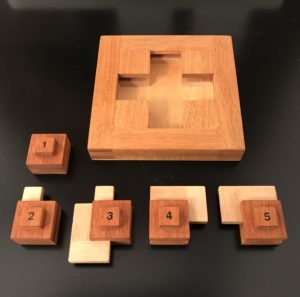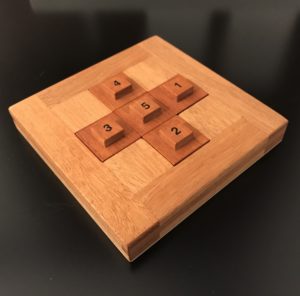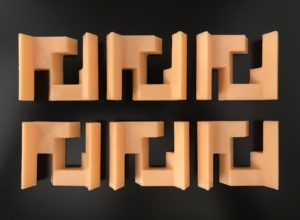CrossFit
My CrossFit puzzle was inspired by two puzzles. First, it was Goh Pit Khiam’s Number Blocks which appeared at IPP35 in Ottawa, Canada. That puzzle had four pieces which danced in and out of a tray with an overhang which made it into an interlocking packing puzzle, which requires a certain number of moves in proper sequence to solve. Not quite your usual 2D style packing puzzle. The second puzzle is Tom Jolly’s Square Dance which has 9 pieces and has a level 1.8.5.3.4 solution.

I was looking to design something that was somewhere in between the two and for the sake of achieving a symmetrical shape, settled in the end for a “cross” shape. And you need to fit 5 odd-shaped pieces into the tray… hence the name CrossFit (which is also the name of a type of high intensity gym workout). Designing wasn’t the problem and my basic design was very kindly scaled up by fellow puzzler Stanislav Knot of the Czech Republic.
I asked Tom Lensch (who had produced copies of my IPP36 Design Competition entry “Magiq #8”) to cut a prototype for me. I was hoping to enter the CrossFit for the IPP37 Nob Yoshigahara Puzzle Design Competition. Tom kindly agreed to do so, but said he couldn’t do so in time for the competition. And while he was very busy with making puzzles for IPP37, he still managed to produce a single prototype copy and passed it to me at IPP37 in Paris. As you can see from the photos, Tom did a great job making the puzzle, even for a prototype.

The goal of CrossFit was to re-arrange a scrambled set of digits into the correct order. To assemble the pieces to the solved state requires 21 moves with a level 1.2.10.5.3 solution. On paper it seems to be a nice challenge of slightly above moderate difficulty. And Tom himself found it pretty difficult to solve too. However, when Tom passed it to Gary Foshee (designer of Lunatic Lock and Open Transparent Lock), Gary shifted the pieces here and there and solved it under 10 minutes. So maybe it wasn’t as challenging as I had hoped. Well, I will see if I can improve the design to a level where I think its good enough for the design competition. Meanwhile CrossFit will remain a nice well-crafted prototype.
Micro Hex
Again here I was inspired by someone else’s design…that of Wil Strijbos! No need to mention the many (metal) puzzles he is well-known for. Just google Wil Strijbos and you can his puzzles and (even get his contact details, I am told). The puzzle of inspiration was his Heavy Metal Triangle Puzzle. Wil’s was a 3-piece puzzle which forms a triangular shape. I was hoping to produce a 6-piece puzzle to form hexagon shape. After much effort with Burr Tools, I managed to come up with a unique solution design for what I thought could work quite well. All 6 pieces were identical and nicey formed the hex version of Wil Strijbos’ Triangle Puzzle. And it required a minimum of 8 moves to remove the 1st piece.

I sent my design to Steve Nicholls who does a lot of 3D printing work including puzzles of course. He has been a great help in 3D printing several other puzzle prototypes for me in the past and his work is very good. He 3D prints all his puzzles for exchange at IPP. In the meantime, I also scouted around for a CNC fabricator that could CNC mill my Micro Hex. There were a several vendors who could do the job but all were prohibitively expensive when it came to just making a single copy. I also contacted and told Wil of my design and asked if he would like to get his fabricator (who had manufactured the Triangle Puzzle) to make my Micro Hex. To my surprise, Wil told me that a long time ago, he had already produced a Hex-shaped metal version with 6 pieces!..but just not as many moves to solve as mine…oh well!

Like Tom, Steve was also busty preparing for IPP but did manage to pass me a yellowish 3D printed copy of Micro Hex in Paris as well as another Hexagon shaped design I called Hexagonal Shift. Steve did comment that Micro Hex did have piece(s) that could rotate during play. Now this is dreaded because rotation means a solver can short cut a move to solve the puzzle in an unintended way by twisting or rotating a piece out of the puzzle easily. I tested out the puzzle myself and found that indeed I could rotate some pieces but only with a bit of force. On hindsight, it was a blessing in disguise that I didn’t proceed with any expensive CNC machining given the rotation problem. As of this writing, Steve will try to make adjustments to the height of the puzzle in the hopes of eliminating any rotational moves. Let see what he comes up with.
